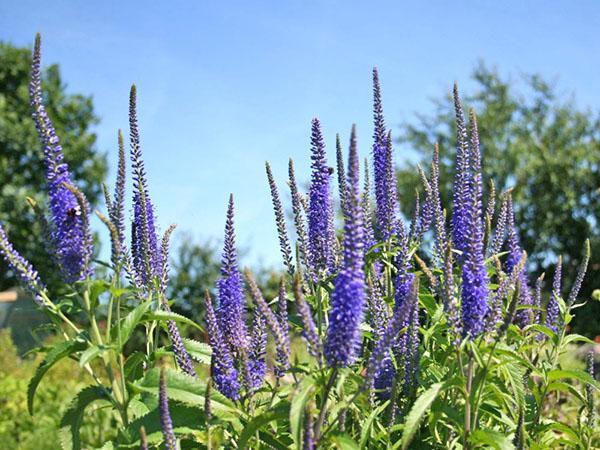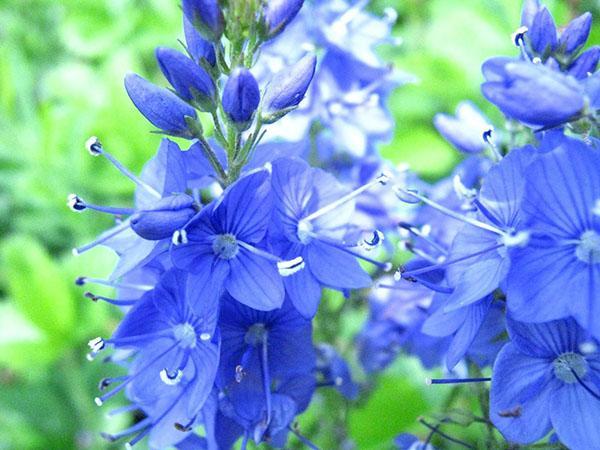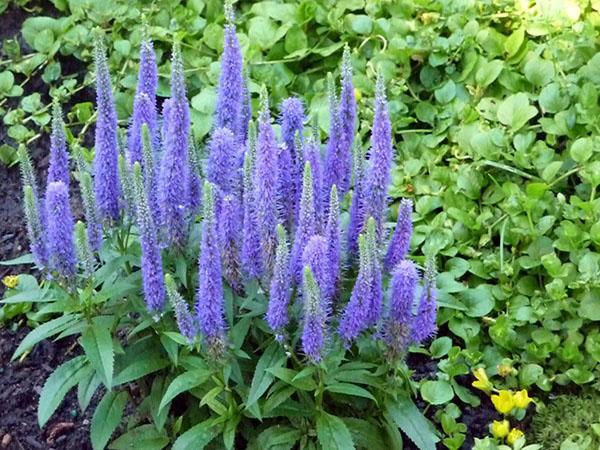Wonderful veronica in the garden
 Veronica in the garden is a real decoration that has an incredibly beautiful appearance. To grow a flower on your site, you will need to follow the rules of care and choose the right place in the flower bed. Then Veronica will delight herself for many years.
Veronica in the garden is a real decoration that has an incredibly beautiful appearance. To grow a flower on your site, you will need to follow the rules of care and choose the right place in the flower bed. Then Veronica will delight herself for many years.
Description of the appearance of Veronica

To prolong the flowering of Veronica, it is recommended to thin out the inflorescences. This must be done as carefully as possible so as not to damage the neighboring shoots and not to remove an excessive number of buds.
Famous types of Veronica:
- Spikelet. This is a short view. An adult bush reaches 40 cm. Leaves are oval, slightly elongated. At the top of the bush, inflorescences appear in the form of long tassels. Their size ranges from 10 to 12 cm. The flowers are bright. Depending on the variety, they can be blue, purple, white. Bloom is observed in June.

- Filiform. In the wild, it can only be found in mountainous areas. Shoots are very thin, long, creeping. The leaves are small, roundish. An adult plant forms a carpet that is abundantly covered with light blue flowers. The buds are small, but very neat and beautiful.

- Big. The root system is creeping. Stems are straight. Their length can be from 30 to 70 cm. The leaves are opposite. Plates of a green hue with pronounced denticles along the edges. Flowers of a deep blue hue. All of them are collected in long, racemose inflorescences.

- Veronica gray is no less popular. A bush grows about 40 cm. At first, the plant has a spreading shape, but at the end of flowering it takes the form of a fluffy pillow. The leaves are wide, grayish-green in color. The buds begin to bloom at the end of July. The flowering period is 35 days.

Veronica in the garden: planting and care in the open field
 Before planting Veronica on her site, remember that she loves sunny places. As for the soil, in this regard, it is not picky. The plant grows well on all substrates, but most of all loves loose, well-drained soils.
Before planting Veronica on her site, remember that she loves sunny places. As for the soil, in this regard, it is not picky. The plant grows well on all substrates, but most of all loves loose, well-drained soils.
Even the smallest drought negatively affects the flowering of Veronica.
Irrigation of Veronica
 The flower loves moist soil, therefore watering it is recommended to carry out systematically, especially on hot days. The plant should be irrigated with warm water, which has settled for several hours. To prevent the leaves from getting burned, the procedure is carried out early in the morning or after sunset.
The flower loves moist soil, therefore watering it is recommended to carry out systematically, especially on hot days. The plant should be irrigated with warm water, which has settled for several hours. To prevent the leaves from getting burned, the procedure is carried out early in the morning or after sunset.
Plant fertilization
 Veronica should be fed organic fertilizers... The first procedure is carried out during the budding period. It is recommended to fertilize areas with poor soil in the fall. Thus, the flower will tolerate severe frosts well.
Veronica should be fed organic fertilizers... The first procedure is carried out during the budding period. It is recommended to fertilize areas with poor soil in the fall. Thus, the flower will tolerate severe frosts well.
Garter bushes
This procedure only applies to tall species. The garter must be done every year as the thin stems cannot withstand strong winds and may break. To do this, use metal structures or garden props, which are sold in specialized stores.
In late autumn, the stems are cut off, and the root system is covered with dry leaves, peat, humus... You can also use pine sawdust and needles.With the onset of spring, all the shelter is removed, and the soil is loosened.
Breeding methods for veronica
 It is not very difficult to grow a young plant in your area. There are several breeding methods that differ significantly from each other. Adhering to the recommendations, each of them is able to give the desired result.
It is not very difficult to grow a young plant in your area. There are several breeding methods that differ significantly from each other. Adhering to the recommendations, each of them is able to give the desired result.
Breeding methods:
- seeds;
- cuttings;
- dividing the bush.
Seed method
 This is the most common way to get a large number of new plants easily.
This is the most common way to get a large number of new plants easily.
If you do not ventilate the mini-greenhouse, then a fungus may appear on the soil surface.
Only high quality grains should be used for planting. They should be placed in small flowerpots at a maximum distance of 5 cm from each other. To deepen the seeds by 3 cm, no more. If you do not adhere to this rule, then the grains may simply not grow.
Keep containers with seeds on windows that are well lit by the sun. For quick germination, it is recommended to cover the flowerpot with transparent polyethylene, periodically watering and airing.
Cuttings
 The advantage of this method is that the plant blooms much earlier and has large buds. The planting material will be separated in early spring. Cuttings are cut from the central trunk. Each of them should be about 10 cm.
The advantage of this method is that the plant blooms much earlier and has large buds. The planting material will be separated in early spring. Cuttings are cut from the central trunk. Each of them should be about 10 cm.
After that, all the planting material is placed in a container with loose soil. It is worth not more than 2 cm to deepen the cut branches. Cover each of the specimens with a plastic bottle or polyethylene. Keep in this state for 1.5 months.
Transplant the rooted cuttings into separate containers. Grow indoors until the soil warms up well. Transplant into open soil in May or early June.
Dividing the bush
This method is often used by gardeners. To divide the flower into several parts, the bush is dug up and only then, with the help of a knife, they cut it. The procedure is carried out in late autumn.
Before planting specimens in a new place, it is necessary to carefully examine the root system. Remove dry and damaged roots, and treat the cut with a special tool.
Photo of veronica in landscape design
 Due to its ease of maintenance and beautiful appearance, the flower is often used for decoration alpine slides and rockeries. Also, Veronica is an irreplaceable part of mixborders. Bushes look good near bodies of water and curbs.
Due to its ease of maintenance and beautiful appearance, the flower is often used for decoration alpine slides and rockeries. Also, Veronica is an irreplaceable part of mixborders. Bushes look good near bodies of water and curbs.
Veronica looks beautiful with a buzulnik, a mountaineer and a badan. Also, the flower is planted along with daisies of different shades. The composition with rose bushes is no less beautiful.  Thus, both types of plants complement each other and seem brighter and more elegant.
Thus, both types of plants complement each other and seem brighter and more elegant.